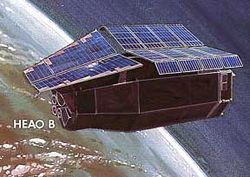High Energy Astrophysics Observatory 2
- High Energy Astrophysics Observatory 2
-

HEAO 2 (Einstein)
Das High Energy Astronomy Observatory 2 (HEAO-2), nach seinem Start auch Einstein-Observatorium genannt, war das erste große Röntgenteleskop im Weltraum mit guter Abbildungsqualität.
HEAO-2 wurde von der NASA entwickelt und am 12. November 1978 mit einer Atlas-Centaur-Rakete von Cape Canaveral aus in eine niedrige Erdumlaufbahn gebracht. Der bis April 1981 in Betrieb befindliche HEAO-2-Satellit hatte das erste große Wolter-Teleskop im Weltraum an Bord. Gegenüber früheren Röntgensatelliten war die Empfindlichkeit stark verbessert und die räumliche Auflösung mit nur wenigen Bogensekunden sehr gut. Diese Verbesserung beruht auf Untersuchungen von Krebsaugen(Crustaceen) von Professor Klaus Vogt und wurde vom Astronom J.L. G. Angel umgesetzt. Neben dem Hauptteleskop mit vier Instrumenten für den Energiebereich 0,15-4,5keV verfügte es noch über einen Röntgenmonitor für den Bereich 1,5-20keV. Mit diesen Fähigkeiten brachte HEAO-2 große Fortschritte in vielen Bereichen der Röntgenastronomie.
Weblinks
HEAO-2 Seite bei NASA (engl.)
siehe auch:
High Energy Astronomy Observatory 1, High Energy Astronomy Observatory 3
Wikimedia Foundation.
Schlagen Sie auch in anderen Wörterbüchern nach:
High Energy Astronomy Observatory — High Energy Astrophysics Observatory can refer to: *1st High Energy Astronomy Observatory (HEAO 1) *Einstein Observatory (HEAO 2) *3rd High Energy Astronomy Observatory (HEAO 3) Note that the correct (original) names for these satellites are High … Wikipedia
High Energy Astronomy Observatory 1 — The first of NASA s three High Energy Astronomy Observatories, HEAO 1, launched August 12, 1977 aboard an Atlas rocket with a Centaur upper stage, operated until 9 January 1979. During that time, it scanned the X ray sky almost three times over 0 … Wikipedia
Ultra-high-energy cosmic ray — Unsolved problems in physics Why is it that some cosmic rays appear to possess energies that are theoretically too high? In high energy physics, an ultra high energy cosmic ray (UHECR) or extreme energy cosmic ray (EECR) is a cosmic ray with an… … Wikipedia
Astrophysics — is the branch of astronomy that deals with the physics of the universe, including the physical properties (luminosity, density, temperature, and chemical composition) of celestial objects such as stars, galaxies, and the interstellar medium, as… … Wikipedia
High Resolution Fly's Eye Cosmic Ray Detector — The High Resolution Fly s Eye or HiRes detector was an ultra high energy cosmic ray observatory that operated in the western Utah desert from May 1997 until April 2006. HiRes utilized the atmospheric fluorescence technique that was pioneered by… … Wikipedia
Harvard-Smithsonian Center for Astrophysics — ▪ research institution, Cambridge, Massachusetts, United States Introduction astronomical research institution headquartered in Cambridge, Massachusetts, U.S., on the campus of Harvard University. The CfA was created in 1973 by reorganizing … Universalium
Trieste Astronomical Observatory — Organization Istituto Nazionale di Astrofisica Location Trieste, Italy … Wikipedia
High-gain antenna — The high gain antenna (HGA) is an antenna with a focused, narrow radiowave beam width. This narrow beam width allows more precise targeting of the radio signal also known as a directional antenna. Most commonly referred to during space missions,… … Wikipedia
Jodrell Bank Observatory — The 76 m Lovell Telescope at Jodrell Bank Observatory … Wikipedia
Compton Gamma Ray Observatory — General information NSSDC ID 1991 027B Organization NASA … Wikipedia

